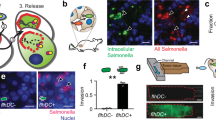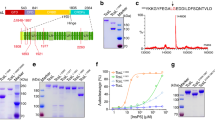Abstract
Vectors combining the heat shock proteins (HSPs) promoter with the catalytic subunit A of the diphtheria toxin (DTA) or its variants, cross-reacting material (CRM) 176 and 197, were engineered to investigate the effect of bacterial toxins on pancreatic cancer (PC) cells. Three heat-inducible enhanced green fluorescent protein (eGFP)-expression vectors were obtained: V1 (91% homology to HSPA6), V2 (five heat shock elements upstream the minimal HSPA6 promoter) and V3 (V1 and V2 combined). The highest eGFP transcription and translation levels were found in V3 transfected PC cells. The V3 promoter was used to control DTA, CRM176 and CRM197 expression, treatment response being investigated in four PC cell lines. DTAwt or CRM176 transfected cell growth was completely arrested after heat shock. CRM197 toxin presumed to be inactive, caused mild distress at 37 °C and induced a 25–50% reduction in cell growth after heat shock. Preliminary in vivo findings showed that heat treatment arrests tumor growth in DTA197 stably transfected PSN1 cells. In conclusion, the efficient HSP promoter identified in this study may be extremely useful in controlling the transcription of toxins such as CRM197, which have lethal dose-related effects, and may thus be a promising tool in PC gene therapy in vivo.
This is a preview of subscription content, access via your institution
Access options
Subscribe to this journal
Receive 12 print issues and online access
$259.00 per year
only $21.58 per issue
Buy this article
- Purchase on Springer Link
- Instant access to full article PDF
Prices may be subject to local taxes which are calculated during checkout





Similar content being viewed by others
References
Jemal A, Siegel R, Ward E, Hao Y, Xu J, Murray T et al. Cancer statistics, 2008. CA Cancer J Clin 2008; 58: 71–96.
Stocken DD, Buchler MW, Dervenis C, Bassi C, Jeekel H, Klinkenbijl JH et al. PC meta-analysis group. Meta-analysis of randomised adjuvant therapy trials for PC. Br J Cancer 2005; 92: 1372–1381.
Bhattacharyya M, Lemoine NR . Gene therapy developments for PC. Best Pract Res Clin Gastroenterol 2006; 20: 285–298.
Cross D, Burmester JK . Gene therapy for cancer treatment: past, present and future. Clin Med Res 2006; 4: 218–227.
Kreitman RJ . Immunotoxins for targeted cancer therapy. AAPS J 2006; 8: E532–E551.
Pastan I, Hassan R, Fitzgerald DJ, Kreitman RJ . Immunotoxin therapy of cancer. Nat Rev Cancer 2006; 6: 559–565.
Fogar P, Greco E, Basso D, Navaglia F, Plebani M, Pedrazzoli S . Killer genes in PC therapy. Cell Mol Biol 2005; 51: 61–76.
Aoki K, Yoshida T, Matsumoto N, Ide H, Hosokawa K, Sugimura T et al. Gene therapy for peritoneal dissemination of PC by liposome-mediated transfer of herpes simplex virus thymidine kinase gene. Hum Gene Ther 1997; 8: 1105–1113.
Bouvet M, Bold RJ, Lee J, Evans DB, Abbruzzese JL, Chiao PJ et al. Adenovirus-mediated wild-type p53 tumor suppressor gene therapy induces apoptosis and suppresses growth of human PC. Ann Surg Oncol 1998; 5: 667–669.
Rodicker F, Putzer BM . pP73 is effective in p53-null PC cells resistant to wild-type TP53 gene replacement. Cancer Res 2003; 63: 2737–2741.
Erbs P, Regulier E, Kintz J, Leroy P, Poitevin Y, Exinger F et al. In vivo cancer gene therapy by adenovirus-mediated transfer of bifunctional yeast cytosine deaminasi/uracil phosphoribosyltransferase fusion gene. Cancer Res 2000; 60: 3813–3822.
Fogar P, Navaglia F, Basso D, Greco E, Zambon CF, Fadi E et al. Suicide gene therapy with the yeast fusion gene cytosine deaminase/uracil phosphoribosyltransferase is not enough for PC. Pancreas 2007; 35: 224–231.
Greco E, Fogar P, Basso D, Stefani AL, Navaglia F, Zambon CF et al. Retrovirus-mediated herpes simplex virus thymidine kinase gene transfer in PC cell lines: an incomplete antitumor effect. Pancreas 2002; 25: e21–e29.
Hajri A, Wack S, Lehn P, Vigneron JP, Lehn JM, Marescaux J et al. Combined suicide gene therapy for pancreatic peritoneal carcinomatosis using BGTC liposomes. Cancer Gene Ther 2004; 11: 16–27.
Kreitman RJ . Immunotoxins in cancer therapy. Curr Opin Immunol 1999; 11: 570–578.
Johannes L, Decaudin D . Protein toxins: intracellular trafficking for targeted therapy. Gene Ther 2005; 12: 1360–1368.
Yang ZR, Wang HF, Zhao J, Peng YY, Wang J, Guinn BA et al. Recent developments in the use of adenoviruses and immunotoxins in cancer gene therapy. Cancer Gene Ther 2007; 14: 599–615.
Uchida T, Pappenheimer Jr AM, Greany R . Diphtheria toxin and related proteins. I. Isolation and properties of mutant proteins serologically related to diphtheria toxin. J Biol Chem 1973; 248: 3838–3844.
Johnson VG, Nicholls PJ . Identification of a single amino acid substitution in the diphtheria toxin A chain of CRM 228 responsible for the loss of enzymatic activity. J Bacteriol 1994; 176: 4766–4769.
Frankel A, Liu JS, Rizzieri D, Hogge D . Phase I clinical study of diphtheria toxin-interleukin 3 fusion protein in patients with acute myeloid leukemia and myelodysplasia. Leuk Lymphoma 2008; 49: 543–553.
Wong BY, Ma Y, Fitzwilson R, Dang NH . De novo maintenance therapy with denileukin diftitox (Ontak) in a patient with peripheral T-cell lymphoma is associated with prolonged remission. Am J Hematol 2008; 83: 596–598.
Shaw JP, Akiyoshi DE, Arrigo DA, Rhoad AE, Sullivan B, Thomas J et al. Cytotoxic properties of DAB486EGF and DAB389EGF, epidermal growth factor (EGF)receptor-targeted fusion toxins. J Biol Chem 1991; 266: 21118–21124.
Mishra G, Liu TF, Frankel AE . Recombinant toxin DAB389EGF is cytotoxic to human PC cells. Expert Opin Biol Ther 2003; 3: 1173–1180.
Vallera DA, Stish BJ, Shu Y, Chen H, Saluja A, Buchsbaum DJ et al. Genetically designing a more potent antiPC agent by simultaneously co-targeting human IL13 and EGF receptors in a mouse xenograft model. Gut 2008; 57: 634–641.
Bardeesy N, DePinho RA . PC biology and genetics. Nat Rev Cancer 2002; 2: 897–909.
Olsen E, Duvic M, Frankel A, Kim Y, Martin A, Vonderheid E et al. Pivotal phase III trial of two dose levels of denileukin diftitox for thetreatment of cutaneous T-cell lymphoma. J Clin Oncol 2001; 19: 376–388.
Duvic M, Kuzel TM, Olsen EA, Martin AG, Foss FM, Kim YH et al. Quality-of-life improvements in cutaneous T-cell lymphoma patients treated with denileukin diftitox (ONTAK). Clin Lymphoma 2002; 2: 222–228.
Frankel AE, Fleming DR, Hall PD, Powell BL, Black JH, Leftwich C et al. A phase II study of DT fusion protein denileukin diftitox in patients with fludarabine-refractory chronic lymphocytic leukemia. Clin Cancer Res 2003; 9: 3555–3561.
Wheeler DS, Wong HR . Heat shock response and acute lung injury. Free Radic Biol Med 2007; 42: 1–14.
Rakonczay Jr Z, Takacs T, Boros I, Lonovics J . Heat shock proteins and the pancreas. J Cell Physiol 2003; 195: 383–391.
Ritossa FA . A new puffing pattern induced by temperature shock and DNP in Drosophila. Experientia 1962; 18: 571–573.
Tavaria M, Gabriele T, Kola I, Anderson RL . A hitchhiker's guide to the human Hsp70 family. Cell Stress Chaperones 1996; 1: 23–28.
Daugaard M, Rohde M, Jäättelä M . The heat shock protein 70 family: highly homologous proteins with overlapping and distinct functions. FEBS Lett 2007; 581: 3702–3710.
Gress TM, Muller-Pillasch F, Weber C, Lerch MM, Friess H, Buchler M et al. Differential expression of heat shock proteins in pancreatic carcinoma. Cancer Res 1994; 54: 547–551.
Ogata M, Naito Z, Tanaka S, Moriyama Y, Asano G . Overexpression and localization of heat shock proteins mRNA in pancreatic carcinoma. J Nippon Med Sch 2000; 67: 177–185.
Aghdassi A, Phillips P, Dudeja V, Dhaulakhandi D, Sharif R, Dawra R et al. Heat shock protein 70 increases tumorigenicity and inhibits apoptosis in pancreatic adenocarcinoma. Cancer Res 2007; 67: 616–625.
Rome C, Couillaud F, Moonen CT . Spatial and temporal control of expression of therapeutic genes using heat shock protein promoters. Methods 2005; 35: 188–198.
Smith RC, Machluf M, Bromley P, Atala A, Walsh K . Spatial and temporal control of transgene expression through ultrasound-mediated induction of the heat shock protein 70B promoter in vivo. Hum Gene Ther 2002; 13: 697–706.
Noonan EJ, Place RF, Rasoulpour RJ, Giardina C, Hightower LE . Cell number-dependent regulation of Hsp70B’ expression: evidence of an extracellular regulator. J Cell Physiol 2007; 210: 201–211.
Ignatenko NA, Gerner EW . Regulation of the HIV1 long terminal repeat by mutant heat shock factor. Exp Cell Res 2003; 288: 1–8.
Indraccolo S, Habeler W, Tisato V, Stievano L, Piovan E, Tosello V et al. Gene transfer in ovarian cancer cells: a comparison between retroviral and lentiviral vectors. Cancer Res 2002; 62: 6099–6107.
O’Connell-Rodwell CE, Shriver D, Simanovskii DM, McClure C, Cao YA, Zhang W et al. A genetic reporter of thermal stress defines physiologic zones over a defined temperature range. FASEB J 2004; 18: 264–271.
Stauffer PR . Evolving technology for thermal therapy of cancer. Int J Hyperthermia 2005; 21: 731–744.
Yamaizumi M, Mekada E, Uchida T, Okada Y . One molecule of diphtheria toxin fragment A introduced into a cell can kill the cell. Cell 1978; 15: 245–250.
Fracasso G, Colombatti M . Effect of therapeutic macromolecules in spheroids. Crit Rev Oncol Hematol 2000; 36: 159–178.
Comanducci M, Ricci S, Rappuoli R, Ratti G . The nucleotide sequence of the gene coding for diphtheria toxoid CRM176. Nucleic Acids Res 1987; 15: 5897.
Kageyama T, Ohishi M, Miyamoto S, Mizushima H, Iwamoto R, Mekada E . Diphtheria toxin mutant CRM197 possesses weak EF2-ADP-ribosyl activity that potentiates its anti-tumorigenic activity. J Biochem 2007; 142: 95–104.
Kimura Y, Saito M, Kimata Y, Kohno K . Transgenic mice expressing a fully nontoxic diphtheria toxin mutant, not CRM197 mutant, acquire immune tolerance against diphtheria toxin. J Biochem 2007; 142: 105–112.
McNeela EA, O’Connor D, Jabbal-Gill I, Illum L, Davis SS, Pizza M et al. A mucosal vaccine against diphtheria: formulation of cross reacting material (CRM(197)) of diphtheria toxin with chitosan enhances local and systemic antibody and Th2 responses following nasal delivery. Vaccine 2000; 19: 1188–1198.
Buzzi S, Rubboli D, Buzzi G, Buzzi AM, Morisi C, Pironi F . CRM197 (nontoxic diphtheria toxin): effects on advanced cancer patients. Cancer Immunol Immunother 2004; 53: 1041–1048.
Acknowledgements
The Authors are grateful to Mrs Monica Razetti and Dr Dania Bozzato for their technical assistance. The study was financed by the Ministero Università e Ricerca (Cofin 2005060715_002), Rome, Italy.
Author information
Authors and Affiliations
Corresponding author
Additional information
Supplementary Information accompanies the paper on Cancer Gene Therapy website (http://www.nature.com/cgt)
Rights and permissions
About this article
Cite this article
Fogar, P., Navaglia, F., Basso, D. et al. Heat-induced transcription of diphtheria toxin A or its variants, CRM176 and CRM197: implications for pancreatic cancer gene therapy. Cancer Gene Ther 17, 58–68 (2010). https://doi.org/10.1038/cgt.2009.48
Received:
Revised:
Accepted:
Published:
Issue Date:
DOI: https://doi.org/10.1038/cgt.2009.48



